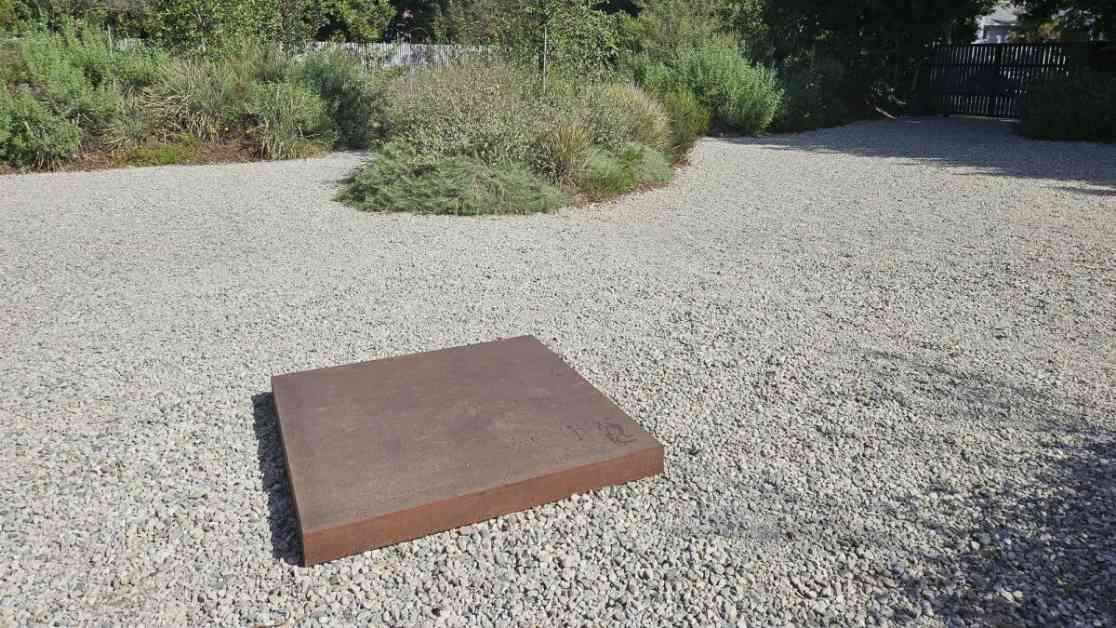In the bustling art scene of Hollywood, the Marian Goodman Gallery proudly showcases a piece of history that sparked controversy and intrigue over five decades ago. A solid steel square, known as “Dark,” crafted by the renowned artist Bruce Nauman in 1968, stands stoically in the back garden of the gallery, beckoning visitors to ponder its enigmatic presence. The sculpture, measuring 4 feet wide and 4 inches thick, holds a rich history that transcends its seemingly minimalistic appearance.
Nauman’s “Dark” made its debut at an annual purchase competition at Southwestern College in Chula Vista, just south of San Diego, where it stirred a whirlwind of emotions among artists and critics alike. Local sculptor Frank James Morgan dismissed the piece as “junk,” while artist John Baldessari fervently defended it in a detailed text, setting the stage for a heated debate that would resonate for years to come.
The sculpture, now the centerpiece of the exhibition “Bruce Nauman: Pasadena Years” at Marian Goodman Gallery, offers a glimpse into Nauman’s creative evolution during his prolific years in Los Angeles from 1969 to 1979. This retrospective features over two dozen works, including sculptures, installations, videotapes, drawings, and prints, providing a comprehensive insight into the artist’s groundbreaking oeuvre.
As visitors navigate through Nauman’s diverse body of work, one piece stands out for its understated complexity – “Dark.” Despite its unassuming appearance, the steel box serves as a testament to the emerging Minimalist aesthetic of the era, challenging viewers to confront the essence of art and perception. The word “dark,” inscribed on the underside of the sculpture, adds a layer of mystery and intrigue, inviting interpretation and contemplation.
Beyond its visual appeal, “Dark” symbolizes a profound connection between artist and audience, rooted in trust and mutual exploration. Nauman’s deliberate choice to leave the word hidden beneath the steel plate underscores the inherent uncertainty and vulnerability of artistic expression, prompting viewers to engage with the work on a deeper, more introspective level.
In a world fraught with social and political upheaval, Nauman’s sculpture serves as a poignant reminder of the enduring power of art to provoke thought and spark dialogue. As viewers grapple with the existential question posed by “Dark,” they are invited to reflect on their own place in a rapidly changing world, mirroring the tumultuous landscape of 1968 and the present day.
Moving beyond the confines of traditional art forms, Nauman’s “Performance Corridor” offers a compelling exploration of space, perception, and self-awareness. The corridor, a seemingly mundane structure built from ordinary materials, challenges viewers to confront their surroundings and question the purpose of their existence. By walking through the corridor and arriving at a blank gallery wall, participants are prompted to ponder the fundamental question: “Why am I here?”
Nauman’s unconventional approach to art invites viewers to embrace the inherent ambiguity and complexity of human experience, transcending the boundaries of traditional artistic expression. Through his thought-provoking installations and sculptures, he challenges us to rethink our preconceived notions of art, identity, and meaning, ushering in a new era of creative exploration and introspection.
As we navigate the intricacies of Nauman’s work, we are reminded of the enduring legacy of artistic innovation and the transformative power of self-reflection. In a world characterized by uncertainty and change, his sculptures serve as beacons of inspiration, guiding us through the labyrinth of human existence with wisdom, grace, and boundless curiosity.














